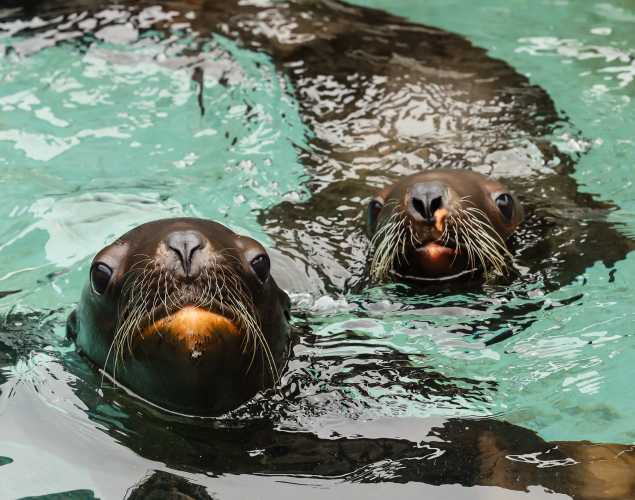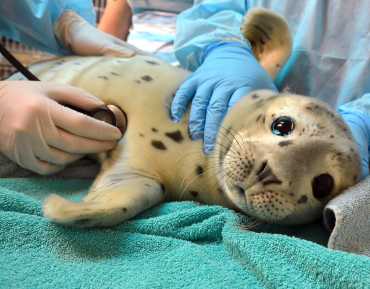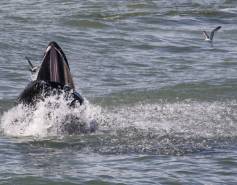
Two Orphaned Steller Sea Lion Pups Get a Second Chance at Life
Two Steller sea lion pups are receiving long-term rehabilitative care at The Marine Mammal Center, the world’s largest marine mammal hospital.
In June 2021, Steller sea lion pup Colby was spotted with no mother in sight in Tillamook, Oregon. Steller sea lions rely on their mothers for about a year as they nurse and learn how to dive, feed themselves and become independent. At only a few days old, this orphaned pup had little chance of survival and it was clear that intervention was needed. Luckily for Colby, our stranding network partner, World Vets, was called to the scene to rescue him from what would have been a devastating fate.
Because Steller sea lions are such social animals, it is vital that orphaned pups learn not only how to feed themselves, but also how to interact with other marine mammals before they are released back to the wild. To provide Colby with the opportunity to socialize with other animals in addition to receiving long-term medical care, he was transferred to our main hospital in Sausalito, where hundreds of sick, injured and orphaned marine mammals are rehabilitated each year.
Only two weeks after Colby was admitted, our response hotline received a call that another Steller sea lion pup was alone on a crowded beach in Watsonville, California. Our trained response volunteers were dispatched, and after carefully monitoring the situation, rescued the orphaned pup. Named Ersa, this 1-month-old pup joined her fellow Steller sea lion at our hospital for life-saving care.
Upon admit, Colby and Ersa were bright, alert and spunky. And while both pups appeared to be in good overall health, our animal care experts had to prepare for a particularly intense and challenging rehabilitation. You see, because the Steller sea lions were so young when they were rescued, they were at a high risk of habituating to humans as they would normally seek comfort and reassurance from their mothers.
To ensure these pups were given their best chance to not only survive, but also to thrive as independent young sea lions upon return to their home in the wild, extra precautions were taken to limit human interaction during their care.
For example, to reduce the need to handle a pup as young as Colby, our veterinary staff diligently coaxed him to transition from tube feeding to bottle feeding within days of his arrival, which was a major animal care success. His bottle was then attached to the pen wall so Colby could drink the nutritious formula without being held. This greatly reduced the chance of him associating food with people.
Colby and Ersa were initially housed together in our intensive care pens, where a camera was installed so our experts could monitor their behavior and progress remotely. While the two Steller sea lions had each other for companionship, interacting with other pinniped species of different ages was also critical to hone their social skills and learn behaviors that would help them survive in the wild.
So as Colby and Ersa got older, our veterinary experts carefully assessed them for compatibility with other patients and housed them with older California sea lions, as well as pups. (Fun fact: Steller sea lions and California sea lions may look similar, but Steller sea lions are lighter in color and grow to be much larger.) California sea lions are also very social and proved to be good role models and companions for Colby and Ersa.
In addition to honing important social skills, patients as young as the two Steller sea lions must also learn how to catch fish on their own in order to be ready for life in the wild. But they first needed to recognize fish as food.
To engage Colby and Ersa’s natural instincts to explore their environment and catch fish, our animal care experts used tactics like manipulating their food so it would float and bob on the water’s surface or sink to the bottom to encourage diving. The pups were also offered a variety of menu items to spur their appetites and curiosity, including herring, squid and shrimp, as they learned how to hunt and eat whole fish on their own.
Colby and Ersa are nearly at the age when they would have naturally weaned from their mothers. During their nine months of care at our hospital, they have mastered critical life skills like catching fish, interacting with other animals and competing for food—reassuring signs that they are survivors. To be ready for life in the wild, they each need to gain a little more weight and then undergo their final release exams.
The opportunity to rehabilitate Steller sea lions not only gives them a second chance at life, but also provides our animal care experts the chance to learn more about this species. Once Colby and Ersa are given a clean bill of health from our veterinarians, they will be fitted with small temporary satellite tags so our scientists can track them once released back in the wild. The satellite tags will fall off on their own within the next six months, but the information we gain, paired with observations and insights gained during rehabilitation, allows us to see how our long-term care helps Steller sea lions thrive in their ocean home.
Did you know it’s only because of support from caring people like you that these pups are receiving life-saving medical treatment? As Colby and Ersa continue to gain their strength and prepare for release in the coming weeks, it’s thanks to ocean heroes like you that second chances are possible.
Header image: Photo by Bill Hunnewell © The Marine Mammal Center
Yes, I want to save a life!

Yes, I want to save a life!
You’ll be giving sick and injured animals the best possible care at the Center’s state-of-the-art hospital. With your gift today, you are giving a patient a second chance at life in the wild.
See Our Latest News
{"image":"\/Animals\/Wild\/Humpback whale\/cropped-images\/humpback whale feeding-29-3-1270-992-1729799785.png","alt":"humpback whale feeding on fish in water","title":"Bay Nature: The Backstory on Pacifica\u2019s Whale Bonanza","link_url":"https:\/\/www.marinemammalcenter.org\/news\/bay-nature-the-backstory-on-pacificas-whale-bonanza","label":"In the News","date":"2024-10-10 02:00:00"}

{"image":"\/People\/Action\/Education\/cropped-images\/youth crew education-79-4-1270-992-1728322151.jpg","alt":"A student stands behind an education table near images of marine mammals, talking to three children and one adult. ","title":"Why Should We Talk About Climate Change?","link_url":"https:\/\/www.marinemammalcenter.org\/news\/why-should-we-talk-about-climate-change","label":"News Update","date":"2024-10-07 02:00:00"}

{"image":"\/Places\/Coastal landscapes\/cropped-images\/shutterstock_palos verdes ddt-0-1-1270-992-1728333594.jpg","alt":"view of Palos Verdes coastline","title":"Newsweek: Toxic Contamination in Our Oceans Can Reach Our Kitchen Tables | Opinion","link_url":"https:\/\/www.marinemammalcenter.org\/news\/newsweek-opinion-toxic-contamination-in-our-oceans-can-reach-our-kitchen-tables","label":"In the News","date":"2024-10-07 02:00:00"}

Newsweek: Toxic Contamination in Our Oceans Can Reach Our Kitchen Tables | Opinion
October 7, 2024
Read More{"image":"\/Animals\/Patients\/Hawaiian monk seals\/noaa-permit-18786-hms-1272-x-992-px.jpg","alt":"Hawaiian monk seal pup in care at the marine mammal center ","title":"Ke Kai Ola Kai\u0101ulu Fest: Seal-abrating a Decade of Ocean Conservation","link_url":"https:\/\/www.marinemammalcenter.org\/news\/ke-kai-ola-kaiaulu-fest-seal-abrating-a-decade-of-ocean-conservation","label":"Press Release","date":"2024-09-20 03:30:00"}

Ke Kai Ola Kaiāulu Fest: Seal-abrating a Decade of Ocean Conservation
September 20, 2024
Read More





